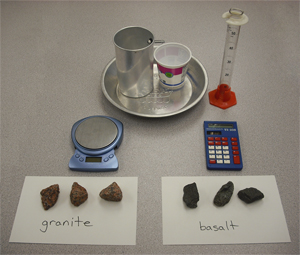Density and Specific Gravity - Sample Problems
(Courtesy of the Science Education Research Center Carlton University)
click here for printable .pdf file (26kb)
Jump to Lab
Problem 1: You have a rock with a volume of 15cm³ and a mass of 45g. What is its density?
Solution: Density is mass divided by volume, so that the density is 45g divided by 15cm³, which is 3.0 g/cm³.
density=mass/volume | density=45g/15cm³ = 3.0 g/cm³
Problem 2: You have a different rock with a volume of 30cm³ and a mass of 60g. What is its density?
Solution: Density is mass divided by volume, so that the density is 60g divided by 30cm³, which is 2.0 g/cm³.
density=mass/volume | density=60g/30cm³=2.0 g/cm³
Problem 3: In the above two examples which rock is heavier? Which is lighter?
Solution: The question is asking about heavier and lighter, which refers to mass or weight. Therefore, all you care about is the mass in grams and so the 60g rock in the second problem is heavier and the 45g rock (in the first question) is lighter.
Problem 4: In the above two examples which rock is more dense? Which is less dense?
Solution: The question is asking about density, and that is the ratio of mass to volume. Therefore, the first rock is denser, (density = 3.0) and the second rock is less dense even though it weighs more, because its density is only 2.0. This example shows why it is important to be careful to not use the words heavier/lighter when you means more or less dense.
Problem 5: You decide you want to carry a boulder home from the beach. It is 30 centimeters on each side, and so has a volume of 27,000 cm³. It is made of granite, which has a typical density of 2.8 g/cm³. How much will this boulder weigh?
Solution: In this case, you are asked for a mass, not the density. You will need to rearrange the density equation so that you get mass.
density=mass/volume
By multiplying both sides by volume, mass will be left alone.
volume x density = mass
Substituting in the values from the problem,
27,000 cm³ x 2.8 g/cm³=mass
The result is that the mass is 75,600 grams. That is over 165 pounds!
Problem 6: Rocks are sometimes used along coasts to prevent erosion. If a rock needs to weigh 2,000 kilograms (about 2 tons) in order not to be shifted by waves, how big (what volume) does it need to be? You are using basalt, which has a typical density of 3200 kg/m³
Solution: In this problem you need a volume, so you will need to rearrange the density equation to get volume.
density=mass/volume
By multiplying both sides by volume, we can get volume out of the numerator (the bottom). volume x density = mass
You can then divide both sides by density to get volume alone:
volume = mass/density
By substituting in the values listed above,
volume = 2000g/3200 kg/m³
So the volume will be 0.625 m³.
Note that the above problem shows that densities can be in units other than grams and cubic centimeters. To avoid the potential problems of different units, many geologists use specific gravity (SG), explored in problems 8 and 9, below.
Problem 7: A golden-colored cube is handed to you. The person wants you to buy it for $100, saying that is a gold nugget. You pull out your old geology text and look up gold in the mineral table, and read that its density is 19.3 g/cm³. You measure the cube and find that it is 2cm on each side, and weighs 40g. What is its density? Is it gold? Should you buy it?
Solution: To determine the density you need the volume and the mass since you know the mass (40g), but the volume is not given. To find the volume, use the formula for the volume of a box volume = length x width x height.
The volume of the cube is
2cm x 2cm x 2cm = 8cm³.
The density then is the mass divided by the volume:
density=mass/volume | density=40g/8cm³ = 5.0 g/cm³
Thus the cube is NOT gold, since the density (5.0 g/cm³) is not the same as gold (19.3g/cm³). You tell the seller to take a hike. You might even notice that the density of pyrite (a.k.a. fool's gold) is 5.0 g/cm3. Luckily you are no fool and know about density!
Calculating Specific Gravity of Rocks and Minerals
Problem 8: You have a sample of granite with density 2.8 g/cm³. The density of water is 1.0 g/cm³. What is the specific gravity of your granite?
Solution: Specific gravity is the density of the substance divided by the density of water, so
S.G.=density of object / density of water = 2.8 g/cm³ / 1.0 g/cm³ = 2.8
Note that the units cancel, so this answer has no units. We say "the number is unitless."
Problem 9: You have a sample of granite with density 174.8 lbs/ft³. The density of water is 62.4 lbs/ft³. What is the specific gravity of the granite now?
Solution: Again, the specific gravity is the density of the substance divided by the density of water, so
S.G.=density of object / density of water = 174.8 lbs/ft³ / 62.4 lbs/ft³ = 2.8
this shows that the specific gravity does not change when measurements are made in different units, so long as the density of the object and the density of water are in the same units.
